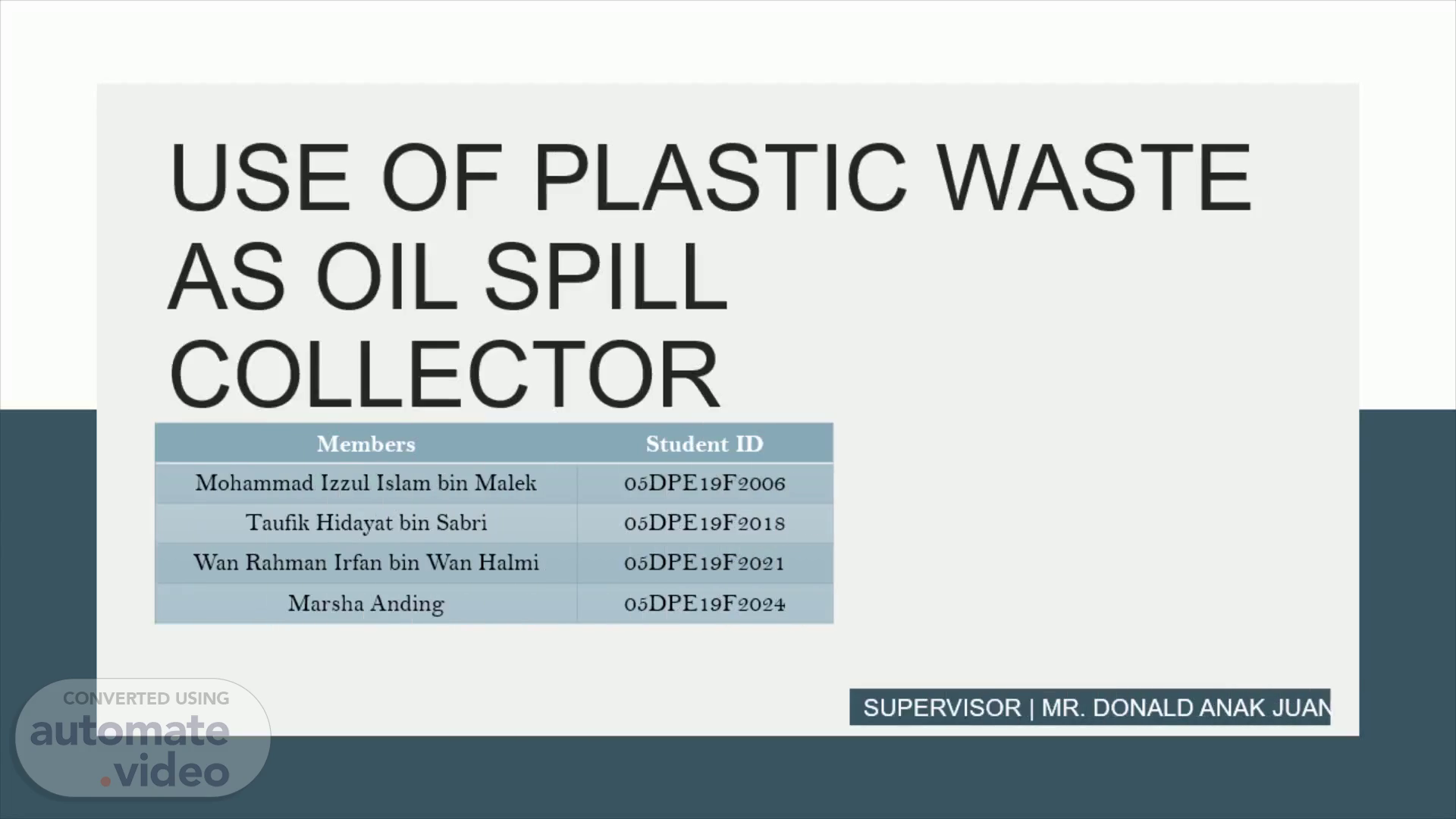Page 1 (0s)
USE OF PLASTIC WASTE AS OIL SPILL COLLECTOR. SUPERVISOR | MR. DONALD ANAK JUAN.
Page 2 (18s)
INTRODUCTION. Humans have used petroleum for medicine or weapons of war for years . Petroleum was not something major until the Industrial Revolution.
Page 3 (41s)
OBJECTIVES. To identify the best parameter between weight and absorption time of an absorber.
Page 4 (1m 0s)
PROBLEM STATEMENT. Decrease of oxygen level in the ocean.
Page 5 (1m 21s)
SCOPE OF STUDY. helps control plastic waste pollution but also clean up oil spills.
Page 6 (1m 44s)
LITERATURE REVIEW. TYPES OF OIL SPILL CLEANING METHODS OIL BOOMS SORBENTS BURN IN-SITU HOT WATER & HIGH PRESSURE WASHING METHODS a barrier that separates between contaminated and uncontaminated areas absorbing sheets that absorbs oil from contaminated area burning of oil in the contaminated area use of hot water and high pressure water to remove oil from contaminated shores EFFECTS takes a long time takes a long time causes air pollution only for on-shore oil spill cleaning.
Page 7 (2m 14s)
METHODOLOGY. HDPE are cut into small pieces and washed with detergent It is further washed with acetone and then cut into small pieces The cut out pieces were then put on a piece of wax paper in the oven to shrink When they cooled down and shrunk, they were put through the grinder to be turned into powder form 100ml of seawater was poured into a beaker with 50ml of used cooking oil. 150g of the powder were added into the mixture to collect the oil The results were recorded In another beaker, 100ml of seawater were added with 50ml of diesel oil. 15 0g of the powder were added into the mixture to collect the oil The results were recorded The procedure was repeated using 100g of coconut husks as additives to the absorber in each mixture.
Page 8 (2m 57s)
results 2. result. RESULTS & DISCUSSION. Presenter: Marsha Anding (05DPE19F2024) CHAPTER 4: Use of Plastic Waste as Oil Spill Collector.
Page 9 (3m 12s)
RESULTS & DISCUSSION. Absorption Rate of Absorber Level of Seawater Level of Diesel Oil Level of Used Cooking Oil Weight of Absorber Time Taken Level of Diesel Oil Collected Level of Used Cooking Oil Collected 100ml 50ml 50ml 300g 3min 20ml 5ml.
Page 10 (3m 34s)
RESULTS & DISCUSSION. Absorption Rate of Absorber + Additive Level of Seawater Level of Diesel Oil Level of Used Cooking Oil Weight of Absorber Weight of Additive Time Taken Level of Diesel Oil Collected Level of Used Cooking Oil Collected 100ml 50ml 50ml 300g 100g 3min 40ml 15ml.
Page 11 (3m 58s)
DISCUSSION. From the results of the experiment, we found that the absorption rate increased with the help of coconut husks as additives..
Page 12 (4m 17s)
C Users 60111 Downloads deepwater horizon turtle jpgdeepwater horizon turtle.
Page 13 (4m 45s)
SUMMARY OF EXPERIMENT COST. No. Equipment/Materials Costs Quantity 1 Recycled Plastic Bottle/Containers - 1kg 2 Coconut Husks RM3 300g 3 Diesel Oil RM20 1l 4 Used Cooking Oil - 150ml 5 Scissors - 1 6 50ml Beaker - 4 7 Stopwatch - 1 8 Seawater - 3l 9 Storage Box RM48 1 TOTAL RM71.
Page 14 (5m 8s)
MILESTONES. photo 2022 05 23 21 04 52. Presenter: Wan Rahman Irfan bin Wan Halmi (05DPE19F2021) CHAPTER 5: Use of Plastic Waste as Oil Spill Collector.
Page 15 (5m 25s)
REFERENCES. Presenter: Wan Rahman Irfan bin Wan Halmi (05DPE19F2021) CHAPTER 5: Use of Plastic Waste as Oil Spill Collector.
Page 16 (6m 7s)
THANK YOU.
